| |
| ... |
|
|
|
|
|
| |
| May 27, 2007 |
|
Finis - Festival Weekend
 Pat Young reports: The 14th annual Fossil Festival, sponsored by the Aurora-Richlands Chamber of Commerce was well attended this year; slight breezes helped make an otherwise hot day a pleasant experience. Once again, the various fossil, mineral and shell clubs displaying at the Community Center (organized by Rich Olsen) proved to be the backbone of the festival. To mention just a few individuals: Joy Pierce-Herrington showed her unusual display of hearing in cetaceans, John Timmerman and crew had a wonderful display of unique and beautiful shells and John Powell showed the latest additions to his efforts in fossil foot restoration of various land mammals. George Powell made the local television news (WITN-TV, Washington, NC) with his well done display of shark teeth and other fossils. The AFF is to be commended for their children's program. Some kids (and parents), remembering Montine Heim from previous years, made that display and the fun activities available, their initial festival destination. Smithsonian Institution scientists identified, among other items, one fossil beaver tooth recently found in Aurora sediments. Pat Young reports: The 14th annual Fossil Festival, sponsored by the Aurora-Richlands Chamber of Commerce was well attended this year; slight breezes helped make an otherwise hot day a pleasant experience. Once again, the various fossil, mineral and shell clubs displaying at the Community Center (organized by Rich Olsen) proved to be the backbone of the festival. To mention just a few individuals: Joy Pierce-Herrington showed her unusual display of hearing in cetaceans, John Timmerman and crew had a wonderful display of unique and beautiful shells and John Powell showed the latest additions to his efforts in fossil foot restoration of various land mammals. George Powell made the local television news (WITN-TV, Washington, NC) with his well done display of shark teeth and other fossils. The AFF is to be commended for their children's program. Some kids (and parents), remembering Montine Heim from previous years, made that display and the fun activities available, their initial festival destination. Smithsonian Institution scientists identified, among other items, one fossil beaver tooth recently found in Aurora sediments.
The interactive displays in the Education Tent, organized by Curtis Ormond, were especially enjoyed by children. Rocky and Kim Culbertson taught kids to knap their own arrowheads and construct rope from common weeds. The Schiele Museum of Gastonia, NC provided a slough to sift for gems and minerals. Duke Marine Lab's live sea urchins proved a huge hit to those brave enough to pick them up. A 20-foot tall blow-up fish, displayed by the Fort Fisher Aquarium, swayed in the breeze and appeared to be swimming. The National Aquarium of Washington, DC showed a video of several of their tanks holding large marine animals, including a 6-foot long moray eel. JoAnne Powell of Beaufort Maritime Maritime Museum (Beaufort, NC) brought a nice display featuring the maritime history of NC. Calvert Marine Museum Fossil Club (Bruce and Marilyn Hargreaves, Kathy Young and Marc Griffin) went beyond the call of duty by setting up tables chairs for everyone before my arrival. Thanks, guys! Their shadowbox displays of marine fossils from Maryland and NC were beautiful and the 4+ foot baleen whale jaw was displayed so all could get a close-up look.

Sponsored by the Friends of the Aurora Fossil Museum, the fossil auction was lively and well organized. Lasting nearly 6 hours, most people came away with a fossil of their choice. Children impatiently waited for their traditional free fossil treats.
PCS provided many tons of extremely rich fossil dirt at various places around Aurora with small chubutensis and large/medium-sized hastalis being fairly abundant. An equal number of adults and children seemed to enjoy the fossil hunt. James Bain generously provided garden mats and plastic bags at each location to make the digging easier. These piles will remain available to the public for months and those visiting Aurora should have good fossil hunting success through the summer.
PCS Phosphate allowed a fossil hunt on Sunday for festival volunteers. Due to previous commitments, I was unable to participate in this adventure, but I did hear one story that bears sharing. For as long as any of can us remember, Candace Holliday has carried a small 'Good Luck Stone' inscribed "PB" in her collecting bag. Although she is an astute collector, for some reason her favorite tooth has always eluded her. On Sunday, only a few feet from the ramp, she finally found her first ever Parotodus benedini. I'm sure her exclamations of delight (most likely an extremely loud whistle) made those nearby wish they had been wearing their earplugs. Congratulations, Candace!!
As PCS Spring Season-2007 comes to a close, we'd like to thank PCS Phosphate, especially the Mine and Public Affairs Depts. for allowing us the opportunity to collect fossils and hopefully add to the scientific database of the Lee Creek fossil fauna.
Editor's note: As we end each season, we need to acknowledge the in-depth, colorful and detailed reporting of Pat Young - she does a great job and we all appreciate it. However, over the years it has taken a toll - first writing the 'news' then those late night discussions with the editor. In an attempt to lessen her burden, we've started to make a concerted effort to have others contribute to this effort. Rick Johnson and Howie Cohn made their first attempts this year while BJ came through as she has in the past. Come fall, it would be nice to have other perspectives included in the 'news'. I (we) would like to solicit other volunteers for the upcoming fall season.
|
| May 19-20, 2007 |
|
Weekend 12 - With a little help from the weatherman
Saturday | BJ Blake reports: Hopes were high in the cool morning air following almost two inches of rain on Thursday; perfect weather was scheduled for today's hunters -- high in the mid-70s with light winds. Today's guests included individuals as well as the members of the Richmond (VA) Gem and Mineral Society, Tidewater (VA) Gem and Mineral, Georgia Mineral Society and the John Hopkins University, APL Fossil and Mineral Club (MD).
Surprise was definitely a reaction at the end of the day when we discovered that not one, not two, but five Carcharodon carcharias teeth were found. Jim Dziczkowski (Aiken, S.C). had three (the largest 1-3/4"), Philip Taylor (Richmond G&M) an almost perfect 1-1/4 inch beauty (image) and Anne Lineberry's rounded out the quintet. Anne also found a gorgeous 3-inch stingray barb (image) as well as a nice bird wing bone; bird bones were also found by Chuck Ball and Pat Young.

Paul Van Hemel (Jacksonville, NC). had a rewarding day by finding a Squalodon premolar with both roots intact and a nice 2-3/4 inch meg. Shawn Royall (Charlotte, NC) also made a fine showing with a beautiful 3-1/4 and 3-inch (missing tip) meg. Other small megs were reported by Candace Holliday, BJ Blake and George Oliver. The largest broad-form hastalis was Carl Miller's (Richmond G&M) and Pam Bryant (Richmond G&M) found two crocodile teeth. Pat Young recovered a very nice Parotodus benedeni (probably lower A1, image) and Candace Holliday a scarce Isurus retroflexus.
There was also the usual array of smaller teeth found - "makos", tigers, Hemiprisitis, etc., as well as at least three Alopias. Bony fish material was also evident, including BJ's bluefish premax (image, with 5 teeth) and a marlin maxilla: porpoise and whale material was also present in the day's take. All-in-all, a good day in the mine and everyone seemed to have a good time.

Sunday | Pat Young reports: As seasoned and novice collectors gathered in the PCS-Aurora parking lot on Sunday, mixed feelings were expressed. Some wondered if there was anything left to find while others, recognizing the closing of this area due to reclamation, felt the responsibility to gather whatever they could in the interest of fossil preservation. Although the temperature had reached 83 degrees by 11 am, the steady breeze provided great collecting conditions for visitors from the National Aquarium (Baltimore, MD) and several private groups.
Sure enough the previous days' hunters had taken their toll of easy pickings. Those doing the Yorktown stroll had less luck than those practicing the Pungo crawl. The largest Carcharocles megalodon (4-3/4 inch and missing a root ear) was found by Brian Dobler (it was still a fine looking tooth). Others, either smaller or damaged, were shown by Matt Rever (a beautiful 1-3/4" chubutensis), Rick Freeman (4-1/4" partial Pungo) and two by Tedo Kordela. Great whites showed up again today with Deb Sneck-Fahrer, Brian Roundtree and Matt Rever showing off their finds. (Who knows how many might have been found this season if the shell beds had been hunted more diligently?) Upper Cosmopolitodus hastalis (broad-from) were some of the best found this season; most were completely exposed for their finders. Jason Toutkoushian (2-1/4") and Calvin Kordela (2") got the largest although there were several others. Lowers tended to be smaller but preservation was excellent. Eric Sadorf got an Echinorhinus (bramble) tooth in matrix while John Everette (who spent the entire day on his knees) was forced to admit he had gone a season without finding one. Sand tiger teeth (overlooked in yesterday's frenzy) were heavily collected and showed-up in great condition -- other teeth were of the more common species. Tim Fahrer enjoyed his first-time find of a wonderful batoid dermal scute (parking lot cleaning techniques can be hazardous so no image was possible). One surprise in today's report was the number of whale vertebrae showing up; although somewhat smaller than early season examples, one has to wonder where they have been hiding.
 During weekend 4 of this season, Anne Lineberry and Dave Sanderson recovered (in the Yorktown clay) a lower symphyseal section of a sperm whale jaw containing two teeth; three others were found by digging in close proximity. Before work could be done to recover more teeth, the area fell victim of the reclamation process. Although prepping is not quite complete, Dave agreed to share this find with us. The teeth are 8 inches long and approximately 1 inch thick. Nice work, Dave! During weekend 4 of this season, Anne Lineberry and Dave Sanderson recovered (in the Yorktown clay) a lower symphyseal section of a sperm whale jaw containing two teeth; three others were found by digging in close proximity. Before work could be done to recover more teeth, the area fell victim of the reclamation process. Although prepping is not quite complete, Dave agreed to share this find with us. The teeth are 8 inches long and approximately 1 inch thick. Nice work, Dave!
As the final day of the regular spring collecting season at PCS winds down, it's time to reflect on changes that will likely be a permanent part of our collecting future here. Given the importance of making previously-mined land available for use again, reclamation will continue to have a direct impact on PCS fossil collectors. Without years of weathering possible before an area can be hunted, collectors will need to rethink old fossil recovery strategies to obtain maximum benefit. Newer hills mean steeper slopes so being physically fit will become more important. The good old days of only lightning and tornados necessitating our departure might have to be adjusted; newly deposited soils on steep hills tend to be hazardous. The great Pleistocene exposures are going to be fewer causing shell collectors some pain. On a brighter note, the movement toward the Yorktown deposits of the 'old days' is steady. The meg teeth will get larger and more abundant. Bony fish material should make a great comeback with prime specimens. The Pungo is already showing examples of fossils not seen for many years; two Ecphora stenomphalus have been found this season and more are sure to follow this fall. We'll adapt, continue to visit in droves and make ourselves content, because to us, Aurora is not just a collecting opportunity but a state of mind.
|
| May 12 & 13, 2007 |
|
Weekend 11 - Begining to wind down
Pat Young reports: Overcast skies both days this weekend kept temperatures low enough for pleasant collecting conditions. Saturday's group consisted of educators from Hampton, VA schools, Catawba Valley Gem and Mineral Club (NC) and independent collectors from several states; while Sunday's group included Smithsonian scientists and an equal number of first-time Aurora fossil hunters.
As spring fossil season nears the end, expectations and results are bound to decline. Knee pads have become more of a requirement in the Yorktown Fm. and occasionally produce outstanding results. Megachasma sp (image) teeth have not been reported since March 2005 (Block 26B) , but Keith Robertson managed to find a real beauty. Eric Fritz got a nice seal canine tooth (image) and John Timmerman a seal vertebra. Only a small bit of crown was visible on a 4-inch Carcharocles megalodon tooth found by Eric Sadorf. Searching the Pungo produced a 3-1/4 inch meg for Nathan Parker and a smaller one for Kurt Keller. A 2-1/4 inch section of wahoo jaw (Acanthocybium solandri) containing 4 teeth was found by Glenn Bolick and Kurt Keller got a small marlin dentary. One Squalodon canine and a crocodile tooth were seen, but other finds were the usual sampling.

Buckets and backpacks appeared heavy as teachers indiscriminately hauled away bones, shells, coral and shark teeth for science classes. One 8th grade teacher accidentally uncovered the nest of a wolf spider (Arctosa littoralis, image); these spiders have large fangs but are harmless.
|
| May 05 & 06, 2007 |
|
Weekend 10 - Bugs, barnacles and hidden beauties
Liz Allyn reports: A chilly and windy Saturday morning blended into a cloudy, overcast day as fossil collectors climbed up and over the sandy, shell-strewn mounds in search of treasure. Collectors from the North Carolina Shell Club, the North Carolina Aquarium at Ft. Fisher, and a few individual collectors were happy to have the opportunity to try their luck at finding shark teeth.
Veteran collectors witnessed that fossil hunting in Aurora isn't like the old days when the big teeth were more plentiful. Years ago, nobody used any digging implements in search of the "big megs" -- surface collecting was the norm. These days some collectors rake the tailings in hope of dislodging something interesting; but most people still stick to surface collecting (walking or crawling). Sounds simple, but actually it does take some practice to do it very well. The well-prepared fossil hunter will be able to spot a tooth if just a portion is exposed on the surface. In fact, two of the largest C. megalodon teeth found on Saturday were found with only a small part visible. These collectors carefully dug around their finds to dislodge the specimens before they could appreciate their true beauty.

Hidden meg teeth were collected by Matthew Rever (5-3/16", based on a small portion of phosphatic-like root) and Ron Edwards (4-1/4", showing a small portion of enamel). Other sizable meg teeth were found by Brian Shields (4-1/2") and Bryan Butt (3"). Worthy of note was a pathological sand tiger (Carcharias taurus) upper found by Russ Byers; measuring 1-1/8 inches to the crooked tip, this is one exceptional tooth (see image). Other finds included pilot & sperm whale, mako, sand tiger and bull shark teeth, as well as assorted fish bones and shells. Indeed, one thing that keeps bringing me back to Lee Creek is the fantastic variety of fossils. I returned home today with fossil remains of more than thirty species representing many different groups. Thanks go to PCS for a great time.
On Sunday, visitors from the National Capitol Fossil Society and a few individual collectors experienced uncharacteristic weather; a Nor'easter brought rain on Saturday night and lots of wind and cool temperatures on Sunday. The day's theme might have been "Chasing Sharks Teeth...and Helmets!" -- nearly everyone exclaimed that their helmet had been blown off at least once. The less than ideal weather forced many hunters back up the ramp early; however, a few collectors braved the harsh winds the whole day. A few small (2-3") megs were taken home by happy hunters.
|
| April 28, 2007 |
|
Weekend 9 - Awaiting the next rain
Pat Young reports: Like farmer's gathered at a country store, the fossil enthusiasts visiting from Calvert Marine Museum Fossil Club (MD.), Black River Fossil Club (SC) and several PCS regulars gathered in small groups to discuss the weather and the previous weeks' fossil bounty. Spring-like temperatures and breezes have finally come to stay but April showers are nowhere to be seen. The news seemed not to affect anyone's ambition -- an energetic crowd boarded the bus.

By last weeks' standards, shark teeth were mostly smaller and less plentiful. The largest megs reported were those by Brian Hempy (3"), Tom Savisky (2-1/2") and Kathy Young (1-3/4"). Craig Healy found a very pretty 1-3/4 inch Hemipritis serra lateral tooth. The shell beds produced two upper Carcharodon carcharias; first time Aurora collector Gerald Fisher found a shiny black 2-incher but Brian Hempy's was missing its root. The Yorktown soils, badly in need of rain, managed to produce quite a few large cuvier teeth and some smaller Cosmopolitodus hastalis (over-looked by last weeks' collectors). Those willing to do a bit of walking managed to pick up a fair amount of Pungo teeth and nice fish fossils. Whale teeth made a decent showing with BJ Blake's the largest (4"); digging provided Ditchweezil a large whale vertebra. Lee Cone (image left) and several assistants spent the day working the whale site he had uncovered earlier in the season. So far the site has yielded ear bones, twenty-five vertebra, eight teeth and most of the skull; much work remains before any identification can be made. Lee wishes to thank all those who have respected this site, enabling him to complete the project. Today's friendly crowd seemed in no hurry; yet, the top-of-the-hill show-and-tell session (image right) was cut short by Candace's "load 'em up" announcement (but continued later in the PCS parking lot).
|
| April 26, 2007 |
|
Aurora Fossil Festival
The 14th annual Aurora Fossil Festival will be held on Saturday, May 26, 2007. Friends of the Museum have arranged two lectures to be held in the museum video room. Dr. Lauck Ward will speak on the Geologic History of the Coastal Plain of NC (10am) and Guy DiTorrice on the Miocene Fossil Fauna of Oregon (2pm). Both these speakers present entertaining and informative programs. The Friends' sponsored fossil auction will begin at 3pm at the museum Learning Center with proceeds to go to the museum. The Community Center will host several fossil clubs as well as the Smithsonian Institution who will have scientists available to assist the public with fossil identifications. PCS Phosphate will again set up its fine fossil display and begin free mine tours at 11am. A parade honoring the Fossil Master (as yet unannounced), fossil dealers, a carnival, petting zoo, street dance and Education Tent (featuring a variety of interesting displays) all help to make this years' festival a fun day for all ages.
|
| April 21-22, 2007 |
|
Weekend 8 - After the Nor'easter
Saturday | Rick Johnson reports: This being my first visit back to the PCS phosphate mine for some six years, it was interesting to see what had changed and what had not. A heavy downpour at the end of the previous week should have refreshed the spoil heaps and with warm weather forecast for this weekend, all appeared perfect.
So with hopes held high, I arrived at the meeting point. Who moved the road? Why is the pit full of water? The place certainly looked a lot different from six years ago, now that the mining had moved to the new area. In the car park, the collectors look the familiar types, some in strange garb and others proudly displaying various 'implements', all designed for the sole purpose of hunting down the prize specimens. Everybody was keen to get started and the normal friendly banter and ritual abuse (as is common amongst fossil collectors prior to a collecting session), was flowing freely.
Some of the groups that attended were: The North Coast Fossil Club from Ohio, Gem and Mineral Society of Virginia Peninsula, The Educators of Excellence Fossil Club from NC, various other independent collectors from various states and myself from the UK. We then signed in, boarded the bus and headed into the quarry.
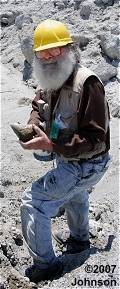 Soon everyone was heading out to the allocated zone and shortly after, you could hear the shouts echoing around the quarry as the first finds were discovered. Megs were being found, as well as Hemipristis serra, Squalodon, Galeocerdo cuvier, Echinorhinus blakei and Notorynchus primigenius to name just some. Soon everyone was heading out to the allocated zone and shortly after, you could hear the shouts echoing around the quarry as the first finds were discovered. Megs were being found, as well as Hemipristis serra, Squalodon, Galeocerdo cuvier, Echinorhinus blakei and Notorynchus primigenius to name just some.
Time flew by and all too soon we had to return to the bus. By my standards, the day had been very hot (mid-70s) and there was certainly a lot to see at show and tell. Megs included: those found by Howie Cohn (5-5/8", image A), Mike Luce (4-1/8"), Carl Fechko (3-1/4"), Linda Supp's patho and many others. Brambles (Echinorhinus blakei) were collected by Becky Hyne, Howie, Jim Bourdon. Luckiest find of the day just has to go to Howie. Some teeth just present themselves to the collector - sometimes just sitting there, sometimes on top of a little pillar to get your attention. Howie found his lovely Pungo Bramble after he left the site, in pearl like fashion, stuck to the inside of an oyster shell (image C).
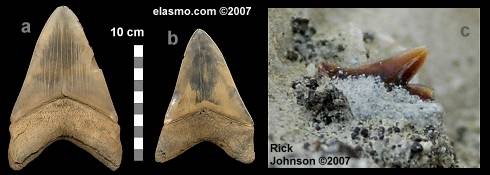
From a personal perspective, my memories of the day were the good company, good collecting and let's not forget: going home very happy with a 4-5/8" Yorktown meg (image B), one small James City meg and two Notorynchus primigenius lowers (plus many other small teeth). I would like to thank the PCS Phosphate Company for allowing me access to the site and to Pat Young, Becky and all the other guides for organizing and leading such an enjoyable and safe collecting trip.
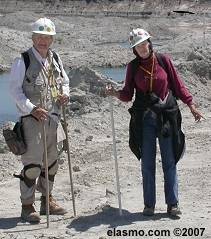 Sunday | Howard Cohn reports: Today found members of the Delaware Valley Paleontological Society, Maryland Geological Society, Southwest Florida Fossil Club and several individuals gathered in the PCS parking lot awaiting the start of their day collecting at PCS's mine. The weather forecast was for a warm day and they were correct; as the day wore on, the importance of bringing and drinking liquids was imprinted on the collectors. Sunday | Howard Cohn reports: Today found members of the Delaware Valley Paleontological Society, Maryland Geological Society, Southwest Florida Fossil Club and several individuals gathered in the PCS parking lot awaiting the start of their day collecting at PCS's mine. The weather forecast was for a warm day and they were correct; as the day wore on, the importance of bringing and drinking liquids was imprinted on the collectors.
On the second day of collecting this weekend, more collectors were bringing shovels and digging for treasure. David Anderson found his 3-1/2" meg this way as did John Keklak with 3 associated shark centra (about 2-1/2" long) and Mike Keklak's three associated 4-inch class megs. Kevin Sweeney celebrated his coming of age by finding his first meg (5" long); what a terrific way to commemorate the passing of ones 18th birthday.
Dave Flinchbaugh collected two whale teeth (4" long, image) and both Marilyn Schneider and John Schmidhauser their first whale teeth from the mine. Everyone brought out a selection of the usual fauna. Teachers were able to collect a wide variety of fossils to use in their classrooms.

All of us who came into the mine were appreciative of the opportunity to collect that was granted to us by PCS through the work of Curtis Ormond, Sr. and the guides who volunteer their time. While collecting at the mine there is no guarantee to leave with a giant tooth but all meet and mingle with a superior class of people whose help, enthusiasm and friendliness is hard to find or match.
|
| April 14, 2007 |
|
Weekend 7 - Before the Nor'easter
Pat Young reports: Unfortunately, spring seems not to have deemed us worthy of the fossil replenishing showers we've badly needed. The eyes of Saturdays' collectors asked the question before it was spoken, "Any rain yet?" Although the answer was negative, the collectors' moods were certainly jolly. These seasoned fossil hunters from Delaware Mineralogical Society, American Fossil Federation, New Jersey Paleontological Society, and others from distant areas, all determined to make the best of the situation.

Following a round of hugs and handshakes, Candace boarded us for the pit. After breaching the far end of the access ramp last week and causing closure of a few areas, the reclamation has rerouted itself and appears to be of no immediate concern. Most people quickly scrambled for a preview of the Yorktown sediments and then settled into a patch of wind swept Pungo. By 10 am, Doug Meyer had found a bramble and two Notorynchus teeth. Other shark teeth of the day included a 4+ inch Carcharocles megalodon (Mike Kelly), 2-1/4" lower Cosmopolitodus hastalis (Candace Holliday), 2-1/4 inch broad-form hastalis (Mel Gulotta) and another bramble (Eric Sadorf). Blair Venables expressed satisfaction at finding quite a few shark vertebrae. Extraordinarily small teeth seem to have a special charm: Mel Gulotta's 12mm Squalodon molar, Becky's 6mm Notorynchus lower and Bob Dann's tiny (8mm) posterior 'meg' (image B) were especially neat.

Other notable finds of the day included an associated seal femur and pelvis bone (Ron Edwards), 4-1/2" sperm whale tooth (Alex Kane), two porpoise/dolphin bullas (Karissa Hendershot), crocodile tooth (Mel Gulotta), seal canine and marlin dentary (image A, Keith Robertson) and a Marginella shell (image C) retaining traces of its original color(Nick Pritchard). With severe storms forecast for Saturday evening, it's a fair bet that the bus will be full both days next weekend!
 Sunday closing -- Due to the impending nor'easter, PCS Public Affairs announced late Saturday evening that Sunday's collecting trip would need to be canceled. Sunday closing -- Due to the impending nor'easter, PCS Public Affairs announced late Saturday evening that Sunday's collecting trip would need to be canceled.
|
| April 8, 2007 |
|
Weekend 6 - An Easter tooth hunt
Pat Young reports: Following an unseasonably warm spell, winter revisited Aurora with a vengence this weekend. Saturday's 30+ mph winds and cloudy skies were accompanied by icy snow which blasted the mine for a short while in the morning hours. Sunday, the morning started with a heavy freeze (20's) but was sunny, if chilly and windy, most of the day. Tampa Bay Fossil Club - FL (what were they thinking?), East Coast Fossil Club - NC, Earth and Ocean Sciences Club of Old Dominion University - Norfolk, VA, members of the Alabama Paleontological Society and non-club affiliated hunters filled the weekend's slots.
Still suffering from a lack of rain, the mine is producing a few outstanding fossils but for most collectors it's the usual small stuff. Topping the Carcharocles megalodon list this week was a very nice upper tooth (4-5/8 inches) found by first-time Aurora collector Bob Wilke (image A). Other great megs and C. chubutensis were shown by Don Carr image (3-1/2" and 2-1/2"), Osmin Alvarado (also a first time collector, 3-1/2") and George Oliver (2-1/2"); several large black re-worked ones were also found. A few nice broad-form Cosmopolitodus hastalis were collected but the narrow-forms seem to have temporarily vanished. A large Hemipristis (1-1/4") was found but most were much smaller. Blowing sands have helped to uncover more eagerly collected Notorynchus (Mark Murphy, image B) and Odontaspis teeth.

Although cetacean fossils are not as abundant, a few large vertebrae did come out this week. Tom Caggiano carried home a limestone boulder containing several beautifully preserved porpoise vertebrae. Jimmy Baldwin marked for later recovery a whale skull destined for an Alabama museum and loaded up a large anterior section of baleen whale jaw. Don Carr found a great Squalodon canine (image D). One seal tooth was found by Cindy Muston (image C) and a seal vertebra was collected by myself. John Everette got a nice Auk sp carpometacarpus (image E). Invertebrate bearing soils are being more frequently collected; producing an Arbacia improcera for Steve Oakley and a neat little keyhole limpet (Diadora auroraensis) and crab claw for Kim Greene.
PCS's reclamation efforts are continuing and are working too well to suit us fossil hunters. It became necessary this weekend to close portions of two windrows nearest the ramp containing some prime Yorktown and Pungo soils. Hopefully, rain, which is forecast for two days next week, will balance the loss as this is likely to be a recurring necessity this season.
|
| April 1, 2007 |
|
Weekend 5 - These boots were made for crawling
Pat Young reports: Visiting PCS this weekend were Aurora Fossil Club and the Beaufort (NC) Maritime Museum on Saturday while Sunday hunters included a group of Marine Biology and Marine Environmental students from Duke University (NC) and independent collectors. The mid-70 temps, bright sun and moderate breezes were a fossil collector's dream. Unfortunately, the heavy rains that pelted surrounding areas earlier in the week had completely by-passed Aurora making the Pungo crawl the most effective method to find large or small fossils.
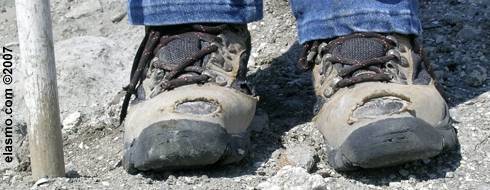
Grady Frame brought out the largest tooth, a 3-inch YT Carcharocles megalodon while Debbie Burdette got a nice Pungo C. chubutensis in matrix. A few others were reported, but most suffered varying degrees of damage. Rocky Culbertson, Ellie Rouse and Chris Muhlsteff showed very nice upper broad-form Cosmopolitodus hastalis teeth and Rich Johnson the largest lower Isurus sp; Rocky and Ellie also got Notorynchus teeth. Although Yorktown teeth are hard to find, Pungo teeth (mostly Galeocerdo and Carcharhinus) are readily available. Marine mammal fossils continue to be collected; Debbie Burdette's porpoise/dolphin partial jawbone (13 tooth sockets) and Bob Werner's partial skull, jaw and a vertebra in limestone matrix were especially noteworthy. Carey Hubbard showed off the first seal vertebra found this season but teeth remain elusive. Nancy Brown got a complete Squalodon canine and a small crocodile tooth.
These recently deposited soils require rain to reveal their full potential; it's forecast for this coming week.
|
| March 30, 2007 |
|
Smithsonian Papers
Over the years, the Smithsonian has placed certain papers on line, but they were not always all that good and the links would disappear. John Schack brought to my attention that the Smithsonian Contributions to Paleobiology series are again available. There are some 96 papers listed, most as hi-resolution pdfs; these are not simple "scanned copies" but excellent reproductions, For example, I downloaded:
Kier (1972) Upper Miocene Echinoids from the Yorktown Formation of Virginia and Their Environmental Significance. #13 (12 MB)
Ray (ed, 1983) Geology and Paleontology of the Lee Creek Mine, North Carolina, #53, (149 MB)
Ray (ed, 1987) Geology and Paleontology of the Lee Creek Mine, North Carolina, II #61, (84 MB)
Buzas & Gibson (1990) Spatial Distribution of Miocene Foraminifera at Calvert Cliffs, Maryland #68, (10 MB)
There are lots of good papers readily available at this site.
|
| March 26, 2007 |
|
Goblin shark video
 Bill Heim brought this neat video from the Tokyo Zoo to my attention. I had some problems getting to view it, but eventually I succeeded. (Seems to require Adobe flash player 9 and a little luck.) Bill Heim brought this neat video from the Tokyo Zoo to my attention. I had some problems getting to view it, but eventually I succeeded. (Seems to require Adobe flash player 9 and a little luck.)
|
| March 24 & 25, 2007 |
|
Weekend 4 - Watch your step!
Pat Young reports: It was nice to see pleasant weather (70's) return for this weekend's hunt. A lovely lavender and pink sky with the sun rising behind the draglines greeted Saturday's visitors. Friends of the Museum and the North Carolina Fossil Club filled this week's slots. Digging and foot traffic have loosened soils considerably and high winds all week had uncovered some fossils; but the lack of rain has proved to be a hindrance. Our entrance into the pit was diverted by a rather ill-tempered snapping turtle (Cheydra serpentina serpentina) who had camped out on the mine ramp and seemed to be annoyed at all the attention he was getting.
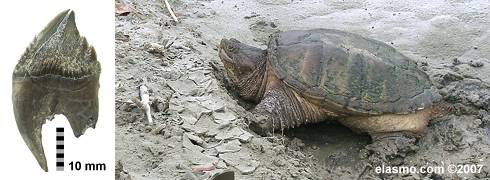
Although some continue to walk in search of concealed bounty, for others a closer to the ground approach has paid off. Saturday, David Wooten scanned a previously worked Yorktown hill and came up with a recently exposed 4-inch Carcharocles megalodon. John Miller and Brian Eelman each got 2-1/2" Pungo C. chubutensis; John also got a nice narrow-form Cosmopolitodus hastalis in matrix. Anne Lineberry found a 3-1/4" YT lower and Becky Hyne a small pathological meg with a twisted crown. Sunday saw a group of collectors sharing the excavation of a Yorktown hill; Bryan Blanton came away the winner with a great 3-1/2" lower meg and a 2-1/2" posterior. While in search of echinoids, Richard Chandler spotted a portion of root that turned out to be an outstanding 5-1/2" meg. Jack Gollahon got a re-worked 4-1/4 incher as well as a 2-inch horse tooth. Teri Caldwell proudly showed her first Notorynchus -- a symphyseal. Becky continues to practice the "Pungo crawl" finding bramble shark teeth both days. Other shark finds were mostly typical Pungo offerings; large sand tiger shark and broad-form hastalis teeth have yet to surface.
Although whale vertebrae are not being seen in former abundance, teeth seem to be getting more common. Anne Lineberry found a piece of matrix with two 5-1/2" sperm whale teeth and large piece of ?jaw bone; three additional disarticulated teeth accompanied the set. Brent McGuirt (image) and George Oliver each got nice Squalodon premolars, Keith Robertson a pilot whale and Ron Edwards an 8-inch reworked sperm whale tooth; several smaller teeth were also shown. Joanne Panek Dubrock found a nice bulla with its posterior process while daughter Xan Dubrock got a basal portion of whale skull and Jeff McGrady, the first whale atlas of the season. Shell collectors are sometimes tolerated with sly grins; Jo Belfiore got the last laugh today -- inside her clam set hid a perfectly preserved small sand dollar!
For next week's visitors, we wish for rain.
|
| March 17 & 18, 2007 |
|
Weekend 3 - Weather, what weather?
Pat Young reports: (Fossil hunters seem to allow nothing to block the pursuit of their passion.) Whether departing in a blizzard, heading south on sleet-covered highways, driving five hours in a blinding rain storm or leaving Rome, Italy's 80 degree sunshine, all gathered in the PCS parking lot with a common goal -- hunt for fossils.
Both Saturday and Sunday collectors suffered under strong winds, which, when combined with temperatures nearly 20 degrees below normal, made for a rough weekend of collecting. Still, the crowd seemed enthusiastic and the takes, if not spectacular, were consistent. Shell and bone hunters got their fill but tooth hunters were mostly restricted to Pungo specimens. Last weeks' rain and heavy digging had rendered the Yorktown soils nearly unworkable.
Saturday, Karissa Hendershot walked away with the gem of the day, a four-inch Carcharocles megalodon (image); Sunday two 4-inchers were reported. Several nice chubutensis were found both days, including those by David Griffith, Jack McNulty and Matt Rever. Paul Murdoch, Scott Tarlo and Keith Robertson showed-off Carcharodon carcharias teeth. The first complete Hexanchus tooth (image) seen this season was found by David Wooten. Other tooth finds were by most accounts typical Pungo offerings, including some nice Notorynchus.
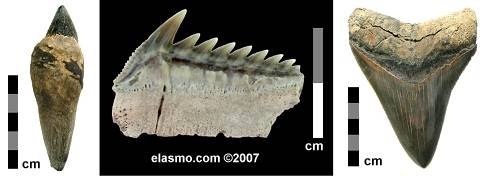
Some great whale teeth were recovered; Candace Hollidays' was the best of the weekend (image). Diana Fattori found a bulla and several flipper bones; unidentified cetacean periotics and humeri were found by others. Whale vertebrae are still being hauled out by the bucketsful and Squalodon teeth (most minus part of the roots) are still being found; Gary Greaser got three associated ones. Lots of interesting ray dermal scutes have been seen, but muddy conditions made imaging them impossible. Fossil fish hunters did well with Richard Habron finding a nearly complete (but disarticulated) fish, a porgy skull and a 2-1/4 " Sciaenops sp. fish jaw. Nando Musmarra got a lower drum fish pharyngeal plate, David Wooten a marlin vertebra and Paul Murdoch a marlin dentary. Nick Pritchard collected a bag full of Volutus typus shells and Maria Gerber burdened under her usual take of treasured 'leaverites'.
Hopefully, drier and warmer conditions might make for more prolific and varied collecting next weekend.
|
| March 10 & 11, 2007 |
|
Weekend 2 - Aurora, better dig it
Pat Young reports: This weekend was sunny with temps in the 70's both days. A light breeze kept us comfortable and the area had dried from the previous weeks' rain, making access to the collecting areas much easier. Both days' collecting will be combined for this report.
Several collectors took mining to a new level this weekend. After choosing a small patch of Yorktown hillside, Matt Wojtko put his shovel to work for the next 4 hours-finishing with spectacular results. Three megalodon teeth later (image), he walked out of the mine with a huge grin on his face; his labor for the day netted a 5-1/2 inch UA-1 as well as a 4-7/8" UA-3 and a 2 " posterior tooth. Fred Hendricks, claiming a similar area, uncovered a 3-1/2" lower posterior and a 2-3/4" upper lateral. Ted Kordela and John Bunch shared a hill and each dug out a large meg (Ted's was 3-3/8" and John's, 4-1/2"). Ditchweezil brought out a 5-inch upper anterior and Ron Edwards showed a 5-5/8" specimen. Steve Ballwanz and Becky Hyne found bramble shark teeth and Elizabeth Simmons, a bramble (?) denticle. In spite of these great finds, the typical Yorktown takes of cuviers, "makos", Hemipristis and sand shark teeth were slim. Ideally a Yorktown area should weather for at least a year or more before optimum results are expected and the recent deposition of these soils is likely the reason for the smaller than usual finds of Yorktown teeth. Pungo soils are providing pretty Hemipristis, large narrow-form hastalis, Notorynchus and the usual smaller teeth.

Marine mammal fossils are still abundant. Several nice seal bones were reported: Joanna Bove found a great seal canine (image) and Ron Edwards a humerus. Steve Kurth got seven associated Squalodon teeth (most dinged) and a partial jawbone. Richard Duden brought out a partial whale skull and two teeth. Others were seen struggling under the weight of large vertebrae. The scarcity of exposed fish fossils made Eric Sadorf's (image) bonita tail noteworthy. Fossil resin (copal/amber) was found by John Bunch and Ron Edwards.
Until the spring rains come with more frequency, probably the best hope of a prolific tooth collecting day will depend on ones use of a rake or shovel.
|
| March 4 & 5, 2007 |
|
Weekend 1 - New Season, New Tailings
Pat Young reports: The much awaited spring fossil season at PCS Phosphate began with a chilly morning which quickly turned into a warm, breezy afternoon -- a perfect day for being outdoors. Sunday would be a cooler day, but yielding similar results. Old friends caught up on winter news and there was much discussion of the "new" collecting area. Curtis Ormond of Public Affairs stopped by to wish us all a productive fossil season. Friends of the Museum made up each day's group of 50 collectors.

The large collecting area, consisting of about equal parts of Pungo River and Yorktown Fm. soils, is north of a bulldozed ramp that runs approximately 1/4 mile across the mine. Hunting grounds consist of 5 hills of tailings deposited since last spring; no vegetation has sprouted. The hills are high and steep; large ponds of water make back-tracking a necessity from some areas. Walking sticks are recommended for even the hardiest collector. It will take some time before these hills weather enough for the true fossil potential to be revealed. Although marine mammal fossils are extremely abundant, shark teeth and bony fish material were less so. Recent rains had made soils very dark, perhaps accounting for the smaller than expected amounts collected this weekend. Continued weathering should make collecting this area more favorable.
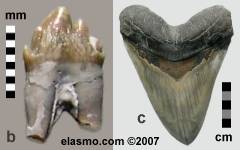 The weekend's collecting produced a nice trophy 6-1/8 inch Carcharocles megalodon tooth (fig. c) for Maria Arredondo. "Megs" from both days, including C. chubutensis, were found by Jim Savia (4-5/8), Amy Kowinsky (4-1/4), Debbie Burdette (3-3/4), Joy Herrington (3-1/4), Ron Edwards (3-1/2), Mel Gulotta (4-1/2) and Eric Sadorf (3-5/8"). 'Bramble' teeth were found by Bonnie Chausseé (E. brucus, fig. d) and Ken Young (E. cookei, fig. e); Bonnie also got 3 Carcharodon carcharias teeth. Dawn Mosteller found a very nice 2-inch carcharias tooth encrusted with tiny oyster shells. Eric Sadorf and Mel Gulotta each found Parotodus benedini teeth and Bob Dann a nice narrow-form C. hastalis in matrix. Notorynchus lowers made a decent showing both days and Anne Linneberry's symphyseal was outstanding. The weekend's collecting produced a nice trophy 6-1/8 inch Carcharocles megalodon tooth (fig. c) for Maria Arredondo. "Megs" from both days, including C. chubutensis, were found by Jim Savia (4-5/8), Amy Kowinsky (4-1/4), Debbie Burdette (3-3/4), Joy Herrington (3-1/4), Ron Edwards (3-1/2), Mel Gulotta (4-1/2) and Eric Sadorf (3-5/8"). 'Bramble' teeth were found by Bonnie Chausseé (E. brucus, fig. d) and Ken Young (E. cookei, fig. e); Bonnie also got 3 Carcharodon carcharias teeth. Dawn Mosteller found a very nice 2-inch carcharias tooth encrusted with tiny oyster shells. Eric Sadorf and Mel Gulotta each found Parotodus benedini teeth and Bob Dann a nice narrow-form C. hastalis in matrix. Notorynchus lowers made a decent showing both days and Anne Linneberry's symphyseal was outstanding.

Other weekend finds of note included: partial walrus tusk (Jeff Sparks and Doug Chausseé), Sea catfish dorsal spine (Sue Yerex), associated set of 7 shark vertebrae (Tim Mosteller), fossil resin (George Klein), juvenile? Squalodon molars (Becky Hyne, fig. b & Kevin Dye) and quite a few nice whale teeth.
As always, one should keep a close watch on the weather forecast as temps can change quickly from one day to the next.
|
| February 16, 2007 |
|
Dates Awarded
By now, the collecting schedule should be available to this year's visitors. The season begins on March 3rd for the Friends, those slots will continue thru March 24th -- the open season commences March 25th and is scheduled to continue through May 20th.
|
| February 01, 2007 |
|
Cretaceous of Texas Reprint
 The long out-of-print The Collectors Guide to Fossil Sharks and Rays from the Cretaceous of Texas Welton and Farish (1993) is again available. . This is a very useful reference for any library -- hopefully this new release will be bound better. Click thumbnail for brief review and ordering link.
The long out-of-print The Collectors Guide to Fossil Sharks and Rays from the Cretaceous of Texas Welton and Farish (1993) is again available. . This is a very useful reference for any library -- hopefully this new release will be bound better. Click thumbnail for brief review and ordering link.
|
| January 12, 2007 |
|
Spring Season Announced
Curtis Ormond of PCS Public Affairs will be taking email requests for the Spring fossil season from January 15 to January 31. If you sent a request earlier, you'll need to resubmit within these dates. The Friends of the Museum will get the first few collecting dates with clubs and individuals following. This season, collecting will be scheduled for both Saturday and Sunday.
Pat Young goes on to note: A ramp has been put in place and we'll be collecting hills in the mine pit this season. Word from mine employees is that the exposures are mostly Yorktown. I haven't had a preview of the area so I have no idea of the size of the collecting area. The same rules as last year apply: No sleeveless shirts or shorts allowed, Steel-toed footwear and photo ID required.
|
|
|